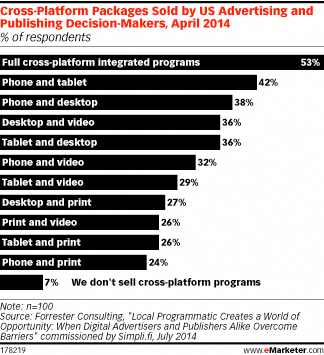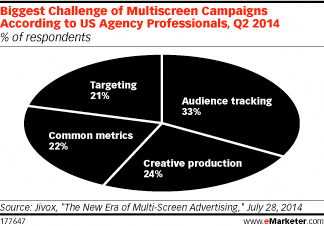Can Marketers Overcome Cross-Device Targeting Barriers?
December 20, 2014
![]() Cross-device targeting is still in its early days, even as growing numbers of advertisers, publishers and ad platforms participate in the practice. Today, there’s no shortage of people promising cross-device targeting solutions, but the incompatibility of those solutions across publishers, platforms and devices can leave advertisers frustrated and their efforts fragmented, according to a new eMarketer report, “Cross-Device Targeting: Success Hinges on Device Identification Methods.”
Cross-device targeting is still in its early days, even as growing numbers of advertisers, publishers and ad platforms participate in the practice. Today, there’s no shortage of people promising cross-device targeting solutions, but the incompatibility of those solutions across publishers, platforms and devices can leave advertisers frustrated and their efforts fragmented, according to a new eMarketer report, “Cross-Device Targeting: Success Hinges on Device Identification Methods.”
 For years, the cookie served as the universal online advertising identifier, enabling buyers, sellers and third-party go-betweens to effectively recognize and reach individuals. But today, as non-web-based digital activities on mobile phones and apps, connected TVs, wearables, connected cars and other IP-enabled devices continue to compose an increasing portion of consumers’ digital media footprints, the cookie’s utility is waning. Yet the need for a universal identifier has never been greater.
For years, the cookie served as the universal online advertising identifier, enabling buyers, sellers and third-party go-betweens to effectively recognize and reach individuals. But today, as non-web-based digital activities on mobile phones and apps, connected TVs, wearables, connected cars and other IP-enabled devices continue to compose an increasing portion of consumers’ digital media footprints, the cookie’s utility is waning. Yet the need for a universal identifier has never been greater.
Marketers’ interest in cross-device ad targeting is clear. In a January 2014 survey of US agency media professionals conducted by research firm Bovitz on behalf of digital marketing personalization firm Conversant, the greatest number of respondents (70%) cited cross-device advertising as the digital advertising topic they wanted to know more about.
 An April 2014 survey, conducted by Forrester Consulting and commissioned by demand-side platform (DSP) Simpli.fi, found 53% of US advertising and publishing decision-makers were already selling full cross-platform integrated programs. Significant numbers of respondents also said they sold cross-device advertising capabilities between pairs of screens, such as phones and tablets or desktop and video.
An April 2014 survey, conducted by Forrester Consulting and commissioned by demand-side platform (DSP) Simpli.fi, found 53% of US advertising and publishing decision-makers were already selling full cross-platform integrated programs. Significant numbers of respondents also said they sold cross-device advertising capabilities between pairs of screens, such as phones and tablets or desktop and video.
Inarguably, the biggest shift that both buyers and sellers must first undergo before making cross-device targeting a reality is to move from sole reliance on the cookie to some other identification tag capable of recognizing an individual across all digital screens, operating systems and browsers. In the absence of such technology, cross-device ad targeting just won’t work.
But accessing and applying that technology at scale can prove challenging, further complicating advertisers’ ability to track and target audiences across screens. In a Q2 2014 survey of US agency professionals conducted by digital display ad platform Jivox, more than half of respondents (54%) cited audience tracking and targeting as the biggest impediments to multiscreen advertising.
Courtesy of eMarketer






























